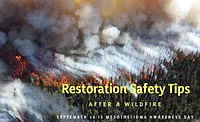Braving the Storm: Safety Tips for Contractors after a Hurricane

According to the team of meteorologists at AccuWeather, there are an expected 12 to 14 named storm systems to occur in 2019. Of these systems, five to seven are expected to be hurricanes and two to four are predicted to be major hurricanes. Major hurricanes can wreak havoc among affected populations. Misplaced families, destruction and debris, and unfortunately, fatalities are common occurrences as a result of these weather phenomena. After the storm has subsided, communities and relief teams work together to rebuild as best they can. Contractors are a crucial part in piecing a community back together. However, there are some safety concerns that they should be aware of prior to sorting through debris and rebuilding properties.
Lingering Asbestos
Once it is deemed that the storm has passed and excess standing water has been drained, the work for contractors begins. Whether it be reconstructing a home or removing rubble, teams are deployed to help. It may seem like a daunting task depending on how much damage has occurred, and the first thought may be to tackle this hands on, but contractors should follow the proper protocol to ensure their safety.
Materials from damaged homes may be scattered throughout and depending on the age of these building materials, toxicants could be present. Homes built prior to the 1980s often harbor asbestos-containing materials (ACMs), which are a known human carcinogen. These brittle materials could release asbestos fibers into the air if handled improperly, exposing those in the immediate area. Asbestos exposure is the only known cause of mesothelioma cancer, a rare and often times fatal malignancy. Contractors that accidently expose themselves to these fibers could very well receive a diagnosis of this disease 10 to 50 years down the line, which is typical, due to its prolonged latency period.
To avoid accidental exposure, contractors should first and foremost have suspected materials tested for the presence of asbestos. Some of the materials that are known to contain asbestos are insulation, roofing shingles, vinyl flooring, and permaboard. If asbestos is detected, a professional abatement team should remove these materials from the worksite so they can be disposed of properly. Once the materials are removed, an air quality test should be completed to check for airborne asbestos fibers. If all steps are followed and each checkpoint has been cleared, contractors can then begin their work.
Damaged Circuits and Live Metals
A hurricane can create issues among electrical wiring and circuits. Not only can this impact the ability of contractors to perform their work, but it is extremely dangerous. Metal materials on the exterior of the home can be “live” if impacted by a downed powerline and contractors should avoid contact with these until an electrician has cleared these materials as safe to handle. On the inside of an impacted home, circuit breakers should be checked for malfunctioning and repaired if necessary. If the home has had serious damage done to its electrical work, contractors will not be able to use their tools, slowing the rebuilding process. All electrical issues should be resolved prior to work so that nobody is at risk of electrocution or having their work hindered by damaged wiring.
Damp Workspaces
As a result of the wet conditions endured during a hurricane, property will most likely be impacted by the amount of rainfall. With hurricanes creating large amounts of standing water, materials are going to stay very damp, even after the water is drained. For contractors that are working in spaces where there are wet materials, they need to be mindful of mold. Mold thrives in wet environments and grows easily on insulation, carpeting, roofing and drywall. An inspection of the premises should be done for mold to prevent exposure. Mold produces mycotoxins which can cause irritation to the eyes and respiratory system. While scientists have found difficulty in linking mold to serious diseases, prolonged exposure could lead to more severe symptoms, especially for those who are allergic or have asthma. Mold should be removed professionally and if you must work where mold is present, a respirator should be worn at all times.
Follow the Correct Protocol
If you are a contractor that specializes in restoration after a natural disaster, always be mindful of the steps you should take to ensure a safe environment. From material testing to wearing the right protective equipment, you should always be prepared for any situation. With the right safety protocol in place, you will be limiting the risks associated with the rebuilding process after a natural disaster.
Looking for a reprint of this article?
From high-res PDFs to custom plaques, order your copy today!








